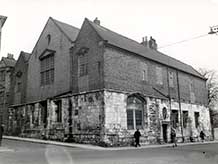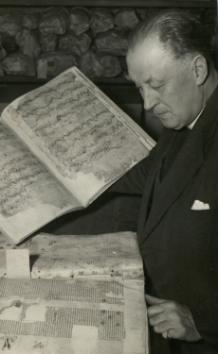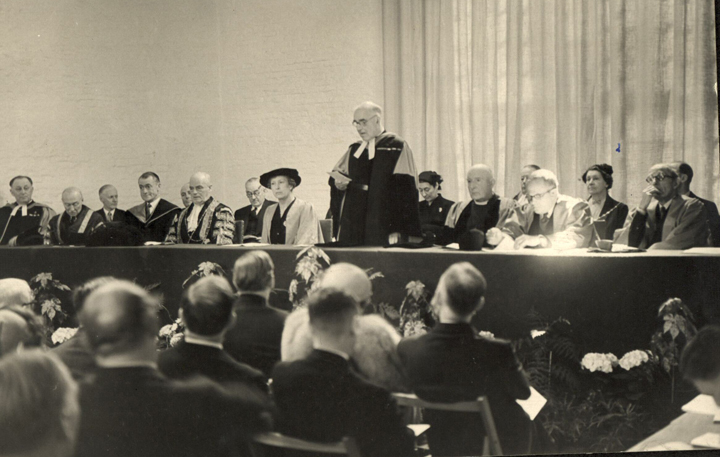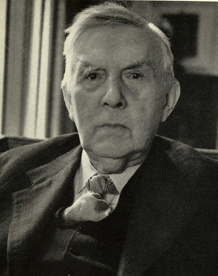Our origins
The Borthwick Institute for Archives has a history which is probably unique among record offices. We were founded as part of the campaign, which began in the 1940s, to found a university in York.
The University campaign
The key leaders of this campaign were Oliver Sheldon, John Bowes Morrell and the Dean of York, Eric Milner-White. These men, with Noel Terry, had founded the York Civic Trust in 1946 in order to preserve what was best of York's historic treasures and promote good design. Their vision for the future of the city was inspired by J.B. Morrell's influential book The City of our Dreams (1940).
Who was J.B. Morrell?
John Bowes Morrell, a director of Rowntree and Co., and chairman of Westminster Press, had a long and distinguished career on York City Council and was twice Lord Mayor; during the early 20th century he was one of York's best known citizens and greatest benefactors and he was a passionate advocate of York's heritage and future potential.
With his brother he began what later became York Conservation Trust, which today cares for a large number of historic properties in York.
It was also through his inspired vision and leadership that the famous Castle Museum opened in York, in 1938.
In 1946-7 the idea of a university unexpectedly began to form part of this vision. The possibility of new universities was in the news in 1946, and Oliver Sheldon energetically spearheaded a local campaign for a university in York. As a result, York became one of a number of places which pressed their claims to the University Grants Committee in 1947. The UGC decided against new universities, but suggested to the York deputation that if it were to prepare an academic scheme it might form the basis of a 'long term policy'.
So the York Civic Trust formed an Academic Development Committee, chaired by Dean Eric Milner-White, and over the next few years, this body – which was succeeded in 1956 by the York Academic Trust – managed and ran a large programme of academic activities designed to keep the university dream alive. The programme included summer schools, courses, and two academic institutes.

St Anthony's Hall c.1950
The Borthwick Institute of Historical Research was the first of the institutes to be opened, at St Anthony's Hall in May 1953.
It was followed by the York Institute of Architectural Study which from 1956 was housed at St John's Church, Ousebridge.
In the late 1950s, government policy changed, York put forward another petition to the University Grants Committee in 1959 and this time it was successful.
The two institutes became departments of the University of York at its opening in 1963.
Oliver Sheldon
Who was Oliver Sheldon?
Sheldon was a director of Rowntree and Co, and a younger colleague of J.B. Morrell. He was the inspirational founding chairman of the pioneering York Georgian Society in 1939. A genius at organisation and publicity, he worked with J.B. Morrell on a number of cultural campaigns within the City during the 1930s. Like Morrell, Sheldon was quick to see and grasp the potential of opportunities as they arose.
Oliver Sheldon can rightly be regarded as the founder of the Borthwick Institute – even though he died in 1951, two years before the Borthwick opened. Our genesis and creation were entirely due to his actions.
In 1949 the Academic Development Committee began to run annual summer schools on architecture and on archives. The archive summer school was directed by the Rev. J. S. Purvis, who as the Archbishop's diocesan archivist was then sorting out the huge, rich archive which dated back to medieval times but was in very poor storage.

Oliver Sheldon
When Sheldon heard, in July 1949, that the scheme to rehouse the York Diocesan Archive in a York Minster Library extension had fallen through, and that a promised £12,000 Pilgrim Trust grant might be available for an alternative scheme, he acted quickly. The archive was now crucial to York Civic Trust's academic plans: not only was it the basis of the archive summer school, but it was already envisaged that the summer schools might – slowly – be developed into institutes. Here was an immediate chance for an institute, giving the academic activities both permanence and a headquarters.
Between late July and early September 1949 Sheldon worked in a frenzy of activity. He developed a scheme in which the diocesan archive would be loaned to York Civic Trust and housed at St Anthony's Hall, a then empty medieval guildhall on Peasholme Green, in an institute of historical research which would bring scholars to York.

Rev J.S. Purvis working on the
York Diocesan archive c.1950
He successfully got all involved parties to co-operate: the Archbishop agreed to the archive loan, York Corporation agreed to the lease of the Hall, and the Deputy Keeper of Public Records, Sir Hilary Jenkinson approved the scheme.
By 1950 Sheldon had gained not only the Pilgrim Trust grant but also a pledge by the Joseph Rowntree Social Service Trust to fund the initial running costs.
The Corporation agreed to spend a generous sum on the Hall's restoration and to lease it at a peppercorn rent.
Meanwhile, Sheldon was conducting intricate negotiations with the Trustees of the late William Borthwick, which led to the institute gaining both its name, and an endowment.
Sheldon died in August 1951. The planning for the Borthwick Institute, and the pursuit of his vision of a university, were carried on by many others in the years after his death, following the strategy and groundwork he had already established.
If you'd like to learn more, Oliver Sheldon and the Foundations of the University of York by Katherine Webb is available via Google Books.
Opening, 1953
The Borthwick Institute of Historical Research, at St Anthony's Hall, Peasholme Green, York, was officially opened on 15 May 1953 by the Princess Royal. The blaze of publicity announced that this would make York a 'World Centre of History'. It was a physical symbol of York's academic aspirations, making the rich York Diocesan Archive widely and publicly available to scholars for the first time and providing a permanent headquarters for the management of York’s academic activities.

The Very Revd Dean of York, Eric Milner-White, Chairman of the Academic Development Committee of York Civic Trust, speaking at the opening ceremony. On his right is HRH the Princess Royal.


